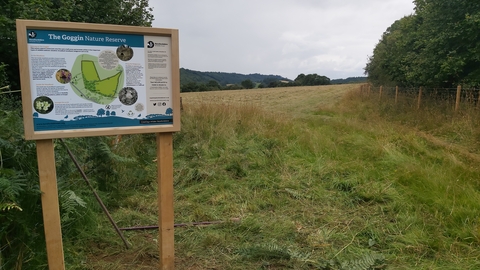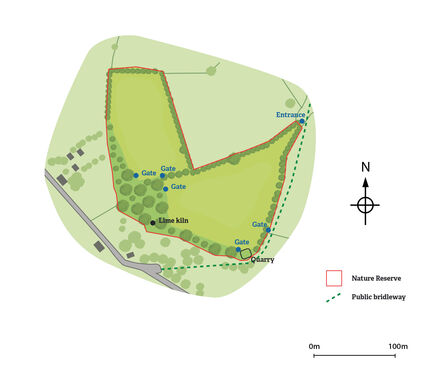
The Goggin Nature Reserve
The Goggin
Location
Know before you go
Dogs
When to visit
Opening times
Daily, dawn to duskBest time to visit
Spring and summerAbout the reserve
In the Meadows
The two lovely meadows provide a home to small mammals when the grass is long meadow and are a fantastic food source for pollinators such as bees, butterflies and beetles when the wildflowers bloom in spring and early summer. The grass is cut for hay each summer then the meadows are grazed by sheep or cattle.
Key species to spot in the meadows in spring and summer: vetchling, perforate St Johns wort, pignut, knapweed, cats-ear, hawkbits, birds foot trefoil, early purple orchid, marbled white butterfly, six-spot burnet moth.
Along the Hedgerows
The fields are separated and bordered by mature hedgerows comprising blackthorn, hawthorn, hazel and field maple. Hedges can act as highways for many birds and animals as they move through our countryside, the thick vegetation hiding them from potential predators.
Key species to spot in the hedgerows: blossoming blackthorn in early spring, yellowhammers and chiffchaff.
Inside the Woodland
The small area of woodland is particularly lovely in spring. The species of woodland flowers which bloom here indicate this may be the site of an ancient woodland.
Key species to spot in the woodland: bluebells, primrose, wild gooseberry, yellow archangel.
Amongst the scrub
Scrub is an area of low, bushy growth and usually includes young trees and shrubs. This is a wonderful habitat where small birds will nest and small mammals such as mice and voles will shelter.
Key species to spot in the scrub: bramble – a good source of food for birds and mammals, blackthorn – another good food source, the fruits are known as sloes.
Don’t miss:
The remains of a single-arch limekiln. The reserve sits on limestone as there is evidence of a small quarry, stone workings and a trackway here too.
There are several magnificent mature and veteran oak trees in the fields and along the bridleway.
The many badger setts around the site.
The old holloway running from Hanway Common to the road
Thank you to John Bayliss who gifted this special place to Herefordshire Wildlife Trust in his Will in 2021.




